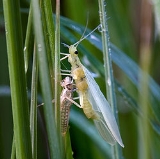Perlodidae, also known as the
Perlodid stoneflies, stripetails, or springflies, are a family of stoneflies.
Natural history
The family Perlodidae is composed of approximately 30 genera and over 103 species, with the fossil records that extends at least since Triassic. The majority of Perlodid stoneflies are univoltine; meaning, that there is one generation per year. Usually, adults emerge from April to June. Many species have an egg diapause during the warmer months, this lets them inhabit otherwise unfriendly environments like temporary seeps or streams. Larvae have a flattened body often with patterns on the head and thorax, a long tail, and divergent hind wing pads. Unlike the similar common stoneflies, Perlodid larvae do not have branching gills on the thorax. The perlodids are found throughout North America.
Habit and Habitat
The Perlodidae are generally lotic and lentic erosional. These habitats are flowing streams or pools that contain sediments, vascular plants, and detritus. They are most often found in cool, clear streams with rocky bottoms. They are found under rocks and also in coarse particulate organic matter (CPOM) where there are many prey to be found. The larvae are generally considered to be clingers as can be seen by their wide stance for gripping substrates.
Functional Feeding Group
The Perlodid larvae are mostly predators that engulf their prey; although, there are a few specied of scrapers and collector-gatherers. They will eat a variety of small invertebrates, but they are also known to eat plant matter, especially when young.
The source of this article is
wikipedia, the free encyclopedia. The text of this article is licensed under the
GFDL.


